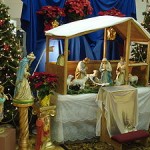For many children around the world, one of the biggest sources of excitement during the holiday season, is the Advent Calendar. Parents buy or make them every year for their children to count down the days until Christmas Eve. There are various options in size, material and content. But no matter what style the parents choose, the most important part is the opening of one door each day starting on December 1st.

But who invented it? It is a true German Christmas tradition. The origins of the Advent Calendar go back to the German Lutherans. The first style, which was used by religious families in the 19th century, was simply to draw a chalk line for every day in December until Christmas Eve. Other families would light a candle every day and put it on a wooden structure, known as the Advent Clock.
The first printed Advent Calendar was made by a Swabian parishioner, Gerhard Lang, in 1908. Lang first produced a board where 24 pictures could be afixed, and several years later added 24 doors. After producing 30 different designs, Lang’s company went out of business and had to close in the 1930s. After World War II this successful tradition was reintroduced in 1946. The first Advent Calendar filled with chocolate was available in 1958.
Today Advent Calendars consist of two pieces of cardboard glued together where 24 doors are cut out in the top layer showing a picture in each. One door is opened every day until Christmas Eve. The last door, number 24, usually is the largest door with either a surprise or a traditional picture of the birth of Jesus Christ.

